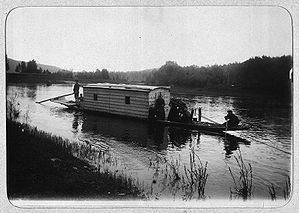Draft 18 cm | ||
 | ||
Notes a river flat-bottomed sail and rowing vessel | ||
Shitik (Russian: Шитик) is a small broad-bottomed vessel in which parts of the hull have been sewed with belts or juniper and fir-tree rods (named vinya Russian: Виня). There are two basic explanations for the origins of the name of these boats:
Contents
Overview
The term Shitik refers to two different vessel types:
Sea Cargo Ship
The Shitik was a keeled vessel, powered by sail and oars. It was used as a sea trade and transport ship. The ship has a rounded off bottom and therefore a considerable expansion of the hull and disorder of boards. This improved the ship's performance.
Shitik had a single mast with a direct sail, oars and a hinged wheel. The vessel had a canopy to protect cargo from the rain; below deck there was a bunkhouse.
The underwater contours of the vessel allowed it to navigate in ice: when compressed it was squeezed out onto the surface. When docking the ship and hauling the anchor, there was an assisting vessel, which helped the crew with these tasks, an osinovka boat.
It is considered that in the 13th century the Shitik was the most widespread coastal transport vessel. Shitiks were mainly built between the 11th–17th centuries. Initially Shitiks were built on the coast of the White sea, and the Northern Dvina, Sukhona, Vychegda, Vetluga, and Tikhvinka rivers. Later the building of such courts preceded development in Siberia and the Far East, when Shitiks plied the Pacific Ocean.
River boat
Shitiks were an important innovation on the Siberian rivers. Many shallows and reefs made a keel useless, and a shortage of nails made it necessary to improve techniques of sewing the planks. It was successfully operated throughout the 18th–20th centuries, being gradually replaced with new types of ship.
When artisan ship builders had the opportunity to use aluminium, the boat found a new niche. It is basically used by hunters and fishermen to reach inaccessible places in the taiga. Making Shitiks is popular on the Lena River in Siberia, Russia.
The design of the boat has been retained, but they are now made of aluminium sheet. Shitiks now have pointed bows instead of sawn off ends. Sails are no longer used; they are powered by outboard motors.
Shitiks are useful in overcoming shoals; they have speed and adequate capacity. The absence of a keel is a problem, as is poor stability. Such a boat does not transfer a wave, and every movement of a passenger risks capsizing the vessel. But this combination of features suits hunters and fishermen, who can use it to cross rivers of 30 centimetres (0.98 ft) – 40 centimetres (1.3 ft) depth.
Well known Shitiks: on the First Kamchatka expedition under the command of Vitus Bering, an auxiliary vessel "Fоrtuna" boat-shitik was used (in other sources it was a two-masted Galiot)
